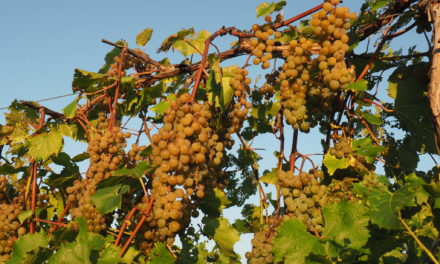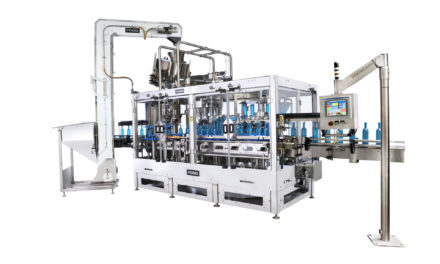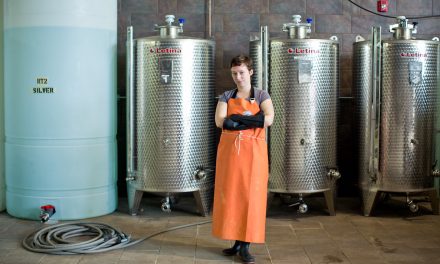When Ben Loseke started hawking used barrels out of his garage in Lincoln, Neb., he had no idea there was a future in the castaway oak containers except as quirky bits of decor. Just five years later, he’s shipping hundreds of barrels at a time to destinations as far away as Japan.
Loseke’s Midwest Barrel Company is one of a handful of barrel brokers. The boom in bourbon making has created a booming business in used barrels, with brewers, distillers, and even vintners searching for distinctive flavors that secondhand barrels can provide.
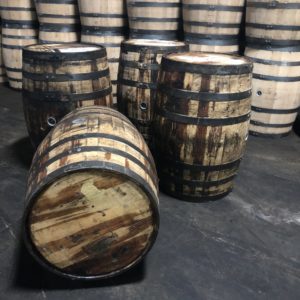
[Photo courtesy Kentucky Bourbon Barrel]
The explosion of interest in American whiskey and the growth of new spirits producers, combined with a surge in aging innovation, has made managing barrels an extraordinarily complicated process, a fast-moving game of supply and demand. Kentucky’s bourbon distilleries alone filled 1.7 million barrels last year, the most in 50 years and, according to the Kentucky Distillers Association, there are about 7.5 million barrels of bourbon currently aging in warehouses. And while not all California wines are barrel-aged, with more than 700 million gallons produced in the state in 2017, that’s a whole lot more oak on the supply side.
The demand side is just as populous. Spirits producers, small and large, are increasingly refining and tweaking their barrel needs, especially when it comes to finishing a spirit. Brewers have taken to barrel-aging their dark and sour beers. Even wineries are finishing wines in ex-bourbon barrels to capitalize on the sweet red trend.
Who sells barrels?
Like barrels, there are all shapes and sizes of barrel dealers, from bootstrapping mom-and-pops that specialize in rarities (such as small village mescal casks and the sweet Bordeaux, Sauternes) to subsidiaries of giant cooperages that can ship millions of barrels around the world annually. But no matter their size, their role is the same—to match buyers and sellers to keep the musical chairs game going.
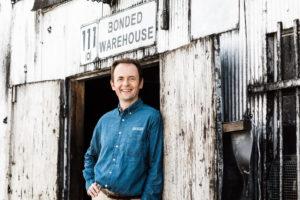
“If we can’t move used barrels, the whole thing grinds to a halt pretty quickly.” —Conor O’Driscoll, Heaven Hill Distillery
“If we can’t move used barrels, the whole thing grinds to a halt pretty quickly,” says Heaven Hill Distillery’s master distiller Conor O’Driscoll. “We have a guy who manages [that aspect of our business] day-to-day, and it’s relatively stressful, because if we don’t move them they pile up.”
Heaven Hill is headquartered in Bardstown, but our distillery is in Louisville. Not sure if this context would be nice for scope of how many barrels the team manages, but the distillery is the largest single-site Bourbon distillery producing 400,000 barrels per year. Heaven Hill Distillery maintains over 1.7 million barrels aging in 60 warehouses throughout Nelson and Jefferson Counties.
With the enormous volume of spirits produced at its Bernheim distillery in Louisville, Ky., Heaven Hill connects with such large firms as Scotland-based Speyside Cooperage and Louisville’s Kelvin Cooperage to distribute the majority of its used barrels to Scotland and Ireland; some head to Mexico for the company’s tequila brand and others go to Caribbean rum makers.
Heaven Hill also sells to brokers. “The used barrel business is incredibly cyclical. Five to 10 years ago, there was a shortage of used barrels. But everybody has caught up and so prices have fallen. Now we work with multiple people to move them on, and we’ll sell them to any willing customer.”
The barrel market right now is in a state of flux due to the pandemic, the impact of international tariffs, and a shift in buyer preferences, says Noah Steingraeber, North America and international craft sales for Louisville’s Kentucky Bourbon Barrel, a full-service used barrel cooperage and subsidiary of Independent Stave Company. But a variety of forces are always moving the market.
Around the middle of the last decade, sales to brewers skyrocketed as they sought used bourbon barrels to age their porters, stouts, and barleywine, as well as wine barrels for sours, spurring new brokers to join the fray. Before that, a minor oak shortage and a whiskey-making boom similarly tightened the market. In the early 1990s, emptied bourbon barrels sold for as little as $5 each, and many distillers simply burned them for fuel. Recently, at peak market, bourbon barrels went for between $160 and $200, with some branded casks hitting much higher prices.
Bourbon, by law, must be aged in new oak, so the industry is the major international source for once-used barrels. Kentucky Bourbon Barrel deals predominantly in bourbon barrels but, like most dealers, procures others used for finishing, including red wine, sherry, cognac, Sauterne, rum, tequila, and brandy. “You name it, we can procure it. We have a lot of resources with different cooperages and can get plenty of barrels with total traceability.”
Supply & demand
H&A Barrel Management, headquartered in Bordeaux, isn’t a broker but rather a barrel management services provider, financing casks in a leasing program, then removing and selling them into the secondary market when wineries and distilleries are finished with them. Currently, the firm manages more than 1,300 wineries with more than 650,000 barrels, with about 100,000 being moved on annually. It’s recently added American distilleries as clients to its enormous winery client base as distilleries have emerged as a growth business.

““Once-used white wine barrels have real added value to the industry, as they maintain high levels of tannins and flavor influence.” —Ken Semour, H&A
According to Ken Seymour, vice president of the company’s spirits division, the needs of the Scotch whisky business drives the market. “Each industry has different needs: In the Caribbean, they’re looking for whiskey barrels; in Scotland, good, tight barrels are needed in abundance,” he says. Most in-demand are sherry casks, which can be expensive (costing upwards of $500 apiece these days) and not always readily available. Port and Sauterne casks are also popular yet hard to come by with consistent quality.
H&A has contracted with its Portuguese customers to take neutral barrels for 6 to 8 month port aging as a less expensive way for distillers to buy port barrels for finishing.
“Everyone always wants sherry barrels, but they’re very expensive. Everybody wants one like I want a Porsche—but it’s $100,000, so I don’t have one,” says Eric Mercier, president of Premier Wine Cask in Napa, Calif.
Premier’s primary concern is new barrels, tanks, and equipment, but selling California wine barrels and used spirits and wine barrels (from its French cooperage partner Tonnellerie Giraud-Galiana) now accounts for at least one-third of its business. It’s an aspect that’s been growing for the last eight years.
In the wine industry, high end one-fill and neutral white and red wine barrels are popular. “Once-used white wine barrels have real added value to the industry, as they maintain high levels of tannins and flavor influence,” says Seymour.

“We need to have someone closer to the source to grade barrels for us.” —Bill Savage, Goose Island Brewing
Making the Grade
Some distilleries let their name become part of the beer finishing branding scheme to cross-appeal to fans of both beer and spirits: Goose Island’s Bourbon County Stouts, a line of limited release brews, has used Heaven Hill’s Elijah Craig, Larceny, and Rittenhouse rye barrels and Old Forester Birthday Bourbon and Weller Bourbon barrels; as well as Wild Turkey, Buffalo Trace, and Knob Creek barrels.
The Goose Island Barrel Program has been important for the brand, says its lead brewer Bill Savage. The program uses anywhere from a couple dozen to a couple hundred barrels at a time, coming from a mix of distillery partnerships and barrel brokers. “We need to have someone closer to the source to grade barrels for us. That’s the biggest thing, working through gradings before we purchase them.”
Soundness and pressure tightness of barrels are key, as are olfactory inspections—a whiff of vinegary acetobacter or nail polish-like acetone reveals a troubled cask likely to end up in the garden as a planter.
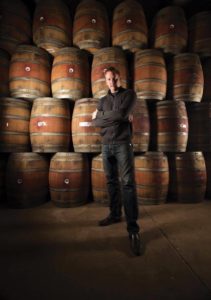
“For the first 10 years or so, our business was about 80 percent brewers, but now it’s flipped to about 80 percent distillers and 20 percent brewers.” —Skyler Weekes, Rocky Mountain Barrel Co.
Barrel stave tightness and proper seasoning aren’t the only factors brokers need to consider when assessing used barrels. Colorado-based Rocky Mountain Barrel Company President Skyler Weekes points out that barrels tainted with acetone or acetobacter are easy enough to catch for the experienced hands. To get his people up to snuff, he brings in coopers for training and three people need to sign off on proper pressure and sniff tests.
Back and forth
Savage has also worked with casks from Islay, Mexico, and the Caribbean, as well as Fernet barrels—and even aged gin barrels (beers aged in this last vessel were a first-time trial and never released to the public).
Like Loseke, Weekes got into the brokerage business almost by accident—but then he went on to fuel the craft beer business. Lately, he’s expanded into importing international casks and now operates three warehouses in the United States, as well as some in Europe, selling tens of thousands of barrels per year. But things are changing for him and other brokers working in the craft beer space.
“For the first 10 years or so, our business was about 80 percent brewers, but now it’s flipped to about 80 percent distillers and 20 percent brewers. Last year, sour beers just dropped off the map in about a month or two, and when COVID-19 hit the United States, lots of brewers just stopped [production]. We’re extremely fortunate that we operate in 49 countries; without the overseas customers, we’d be in a really bad place.”

“In a market that’s oftentimes saturated, it’s nice to have a unique niche.” —Matt Thomas, Northeast Barrel Co.
At Pennsylvania-based Northeast Barrel Company, co-owner Matt Thomas started by serving craft brewers, then expanded to wine, spirits, and coffee with a focus on harder-to-find vessels from Mexico and Europe. “In a market that’s oftentimes saturated, it’s nice to have a unique niche,” he says. Thomas is working toward expansion by developing more Oaxacan sources—he’s sold some agave barrels to Paso Robles, Calif.-based Firestone Walker Brewing Company—and working on sourcing barrels that were used to age a sherry-like fortified Mexican red wine.
Short- and long-term outlook
Right now, the slowdown in barrel transport as distilleries work at COVID-19 speed means many barrels will be too dry for brokers to sell on. Wineries are trending toward reusing barrels more, which may put a crimp in the supply soon. Craft brewers have been opting increasingly for local craft distiller barrels, although what will happen to craft beer and spirits businesses post-COVID is anyone’s guess.
But as long as producers strive for an advantage or a new niche, turning to barrels—new, used, recharred, recoopered, oak, maple, amburana, or even those previously used to store coffee or tea—will continue to be a crucial implement in their tool boxes.


